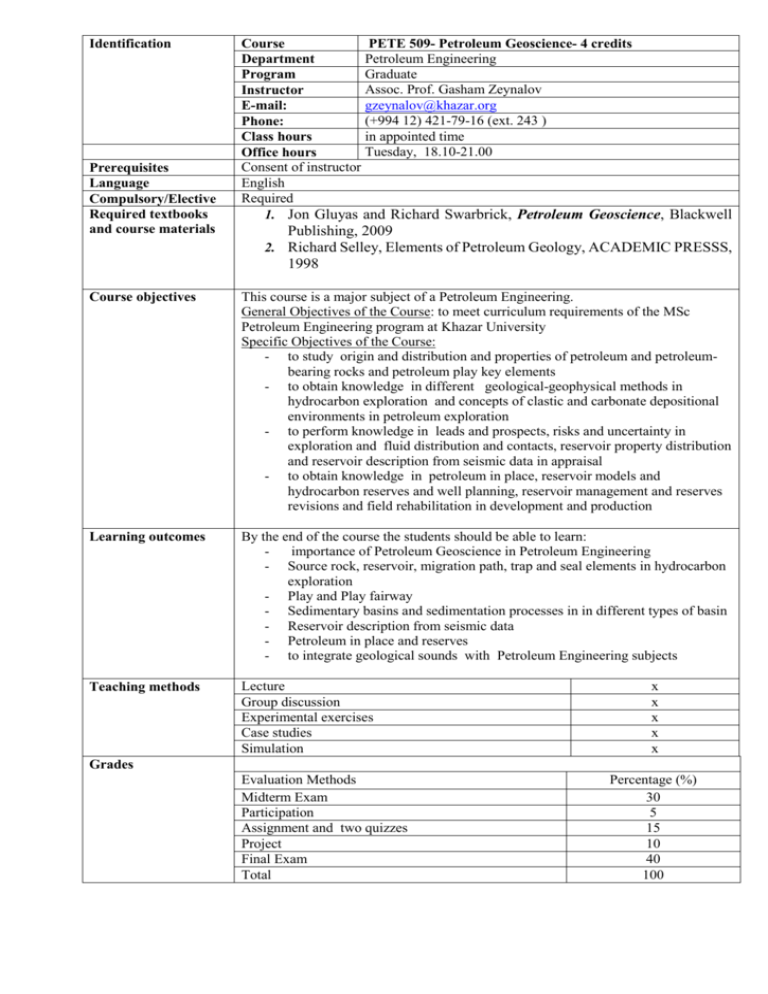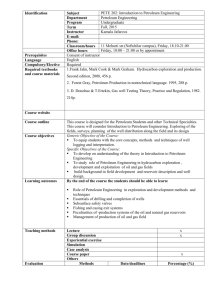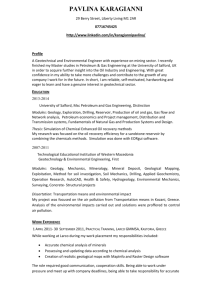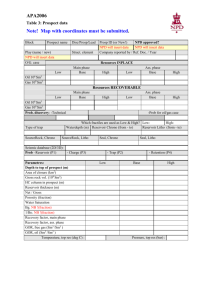Identification - Khazar University
advertisement

Identification Prerequisites Language Compulsory/Elective Required textbooks and course materials Course PETE 509- Petroleum Geoscience- 4 credits Petroleum Engineering Department Graduate Program Assoc. Prof. Gasham Zeynalov Instructor gzeynalov@khazar.org E-mail: (+994 12) 421-79-16 (ext. 243 ) Phone: in appointed time Class hours Tuesday, 18.10-21.00 Office hours Consent of instructor English Required 1. Jon Gluyas and Richard Swarbrick, Petroleum Geoscience, Blackwell Publishing, 2009 2. Richard Selley, Elements of Petroleum Geology, ACADEMIC PRESSS, 1998 Course objectives This course is a major subject of a Petroleum Engineering. General Objectives of the Course: to meet curriculum requirements of the MSc Petroleum Engineering program at Khazar University Specific Objectives of the Course: - to study origin and distribution and properties of petroleum and petroleumbearing rocks and petroleum play key elements - to obtain knowledge in different geological-geophysical methods in hydrocarbon exploration and concepts of clastic and carbonate depositional environments in petroleum exploration - to perform knowledge in leads and prospects, risks and uncertainty in exploration and fluid distribution and contacts, reservoir property distribution and reservoir description from seismic data in appraisal - to obtain knowledge in petroleum in place, reservoir models and hydrocarbon reserves and well planning, reservoir management and reserves revisions and field rehabilitation in development and production Learning outcomes By the end of the course the students should be able to learn: importance of Petroleum Geoscience in Petroleum Engineering - Source rock, reservoir, migration path, trap and seal elements in hydrocarbon exploration - Play and Play fairway - Sedimentary basins and sedimentation processes in in different types of basin - Reservoir description from seismic data - Petroleum in place and reserves - to integrate geological sounds with Petroleum Engineering subjects Teaching methods Lecture Group discussion Experimental exercises Case studies Simulation x x x x x Grades Evaluation Methods Midterm Exam Participation Assignment and two quizzes Project Final Exam Total Percentage (%) 30 5 15 10 40 100 Academic integrity Students are responsible for the honest completion and representation of their projects, for the appropriate citation of sources, and for respect of others academic endeavors. Plagiarism and other forms of academic misconduct are serious offenses with severe penalties. Week Tentative Schedule Dates Topics Textbook/Assignments Introduction to the Petroleum Geoscience Importance Petroleum Geoscience in the Petroleum Engineering 1 2 3 4 5 7 8 15.09.2015 22.09.2015 29.09.2015 06.10.2015 13.10.2015 20.10.2015 27.10.2015 Geological exploration at different scales Chapt. 1(1) Frontier Exploration: Direct Petroleum Indicators: petroleum leakage and seepage: Identification of petroleum in seismic data chapt.3.3(1) Sedimentary basins: extensional, intracratonic, rift, foreland basins and passive margins Basin History: Subsidence, sediment supply, burial history, thermal history, uplift, pressure history and integrated basin modeling chapt.3.4,3.5(1), 8(2) Principles of Stratigraphy and The Geological Time Scale, Chronostratigraphy, Biostratigraphy, Lithostratigraphy, Seismic Stratigraphy. Chemostratigraphy and magnetosratigraphy methods Rock Unit relationship and Sea-Level Unconformities in sedimentation process Interpretation of stratigraphic unconformities on outcrops and field geologic cross-sections Chapt.3.6(1) Source Rock: Origin of petroleum from living organisms, Kerogen and its types, Maturation of Source rock: kerogen to oil to gas Chapt3.7 (1). Chapter 1(3) Exploration and exploitation: Seal, Reservoir and its intrinsic properties: net to gross, porosity, permeability and hydrocarbon saturation Reservoir Lithologies Chapt. 4.2,4.3(1). 7(2) Sandstone depositional systems: Alluvial fans, Aeolian dunes, lakes, fluvial systems, deltas, shallow marine systems, submarine fans Quiz 1 Chapter 4.3 (1), 6(2) 9 10 10 11 12 13 14 15 03.11.2015 Mid –term exam Chapter 4.3 (1) 3(2) 10.11.2015 Carbonate depositional systems: Shelfal and ramp carbonates, reefs, deep-water carbonates, karst Fractured reservoirs Migration: Primary, secondary and tertiary migrations The Trap: Trap types, migration and trap formation, Structural traps, stratigraphic traps, hydrodynamic traps Chapt.4.4,4.5 (1), 5,7(2) Petroleum Play and Fairway: play, play fairway, Lead and Prospect: Lead, prospect and prospect evaluation, prospect inventory, well prognosis Risk and uncertainty Chapt.4.6, 4.7(1), 5(2) Appraisal: The trap envelope: depth conversion Mapping surfaces and faults Spill points Fluid distribution and contacts: fluid contacts and transition zone Intra-field variations in petroleum composition Intra-field variation in water composition Chapt.5.1,5.2(1), 6(2) Chapter 5.5,5.6 (1), 6(2) 08.12.2015 Reservoir property distribution: lithofacies and lithotypes, reservoir body geometry, reservoir correlation Reservoir quality: More intrinsic reservoir properties, controls on reservoir quality, compaction and cementation in sandstones, compaction and cementation in limestones Chapt.5.7,5.8(1), 6(2) 15.12.2015 Reservoir description from seismic data: lithology description, porosity determination, lateral variations and reservoir heterogeneity, reservoir correlation, identification of fluid types and contacts Petroleum in Place and reservoir models: petroleum in place, geologic models, reservoir models, reserves Chapt.6.2,6.3(1), 6.9(2) 22.12.2015 Development and Production Well planning and execution: facilities location and well numbers, well geometries, well types, drilling hazards, well completion and stimulation, formation damage, well logging and testing 17.11.2015 24.11.2015 01.12.2015 Reservoir management: reservoir description from production data, reservoir visualization, Time-lapse seismic, managing decline and abandonment Quiz 2 TBA Final Exam








